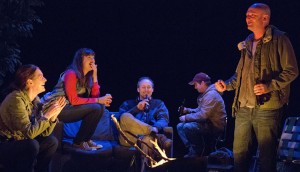Anne Washburn's ambitious but labored Mr. Burns is subtitled A Post-Electric Play. The central conceit is that in the future an undefined catastrophe has occurred (there are references to a quarantine, a “bug,” and empty and burned cities). All electricity has stopped, and worse, nuclear power plants are melting down. Around a campfire (niftily envisioned by designer Neil Patel as a smoking TV set), a group of survivors share stories about episodes of The Simpsons to keep their minds off their plight.
The title refers, of course, to Homer Simpson's villainous boss at the nuclear plant in the cartoon series. Meanwhile, the principals (all carrying the same first names as the actors who play them) try to piece together TV episodes from jumbled memories as if each were another Homer — the blind Greek one — assembling The Iliad; they falter and trail off and balk and interrupt one another. Although the play was partly developed by the actors' own reconstruction of an episode, which may account for some self-indulgence, it's a plodding start to a demanding play. One wishes director Steve Cosson had sped things up a bit.
Among the most proficient of the reconstructors is Matthew (Matthew Maher), whose most helpful colleagues are Susannah (Susannah Flood) and Jenny (Jennifer R. Morris). Their reconstruction, however, is suddenly interrupted by a stranger, Gibson (Gibson Frazier), who arrives from Framingham, Mass. In one of Washburn’s best ideas, the campfire group asks his story, and then each, following a custom that has apparently arisen among the refugees and survivors, reads 10 names from a personal log in hopes that Gibson will have information on the survival of someone in the log that he carries; Gibson, in kind, reads 10 names as well. Although it's time consuming, one senses the isolation and disappointment as name after name brings no response.
Beset by fears of radioactive fallout from disabled plants, they trade rumors of heroic last-ditch efforts, underground seepage and no-go zones, and then they return to The Simpsons. Other bits of pop culture, from the film Cape Fear, with Robert Mitchum, and the remake with Robert De Niro, to Gilbert and Sullivan operettas, also bubble up.
In the second scene, seven years have passed. The principals have been joined by Quincy (Quincy Tyler Bernstine), and they are preparing to put on a Simpsons episode, albeit on a shoestring. During the intervening years, rival troupes have popped up (as well as theater circuits), all laying claim to various episodes of The Simpsons. It may be amusing or disheartening that what these performers want to preserve seems so trivial next to Shakespeare or Moliere or Chekhov, whose works, one must assume, cannot be remembered so well.
Nonetheless, there are suggestions that civilization is making a comeback; there are haves and have-nots, and Gibson offers the opinion that Chablis will come back into fashion because “people are ready for status again.” In this world, though, wealthier troupes pay for lines to Simpsons episodes that are remembered by various people, and shysters try to sell bogus lines or claim credit for lines that they had nothing to do with. And the actors find solace in the high quality of their commercials. (Washburn doesn't clarify whether they are presented during the play.) The cast rehearses their episode, but the scene ends with a twist drawn from other kinds of TV series, such as 24 and Strike Back.
A leap forward of 75 years brings a well-appointed troupe —with nicely painted backdrops and excellent lighting (Justin Townsend’s work is exemplary in all three segments), performing an episode of The Simpsons in costumes and striking half-masks. There is music (by Michael Friedman). The result is a pastiche of The Simpsons that incorporates bits of G&S, a Greek chorus, rap, and the catch phrase from the 1940 Bob Hope vehicle The Ghost Breakers: “Feets, don’t fail me now!” A reference to Chablis suggests that the original script of the shoestring company has served as the template for the production.
In its own way, Washburn’s apocalyptic drama echoes the history of theater, as culture forms and re-forms itself, passing through natural disasters and war and accruing .classic bits over time. The idea is full of promise, but the work is too often taxing rather than compelling, and feels ramshackle at times. Even so, the actors work hard, and they are all good. Sam Breslin Wright has the title role, but the plays-within-the-play are too cumbersome, and the whole enterprise, calculated to spark one’s intellect, ends up numbing the mind.



